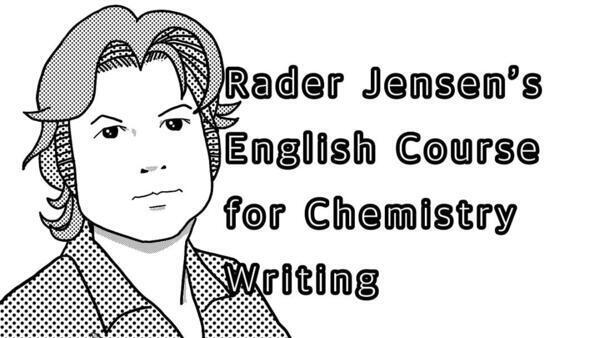[化学論文のための英語講座] 第78回:要旨の復習 Abstract Review
2025年4月22日

(English version is here.)
動詞の時制の使い分けは、一つの文節だけではなく、周囲の文脈にも繋がります。文章全体を通して動詞の時制を慎重に選択することで、著者が伝えようとしていることが伝わり、読みやすさが向上します。次の要約では、段落全体にわたってなめらかな流れをもたらす動詞を、括弧内から選択してください。厳密に言えば、全ての選択肢が文法的に正しいことに注意してください。
Abstract: (S)-1-Phosphaethenyl-2-diarylphosphanylferrocenes with planar chirality (Fc(CH=PMes*)PY2 (1a), PYPh (1b)) (1 are/were/have been) prepared by the phospha-Peterson reaction of optically active 2-phosphanylferrocenecarboxaldehydes with Mes*P(Li)SiMe3 in THF in high yields. The absolute configuration of 1b (2 is/was/has been) determined by X-ray diffraction analysis. Compounds 1a and 1b readily (3 react/reacted/have reacted) with [PtMe2(m-SMe2)]2 in Et2O to afford dimethyl complexes with bidentate coordination of these ligands (PtMe2(L): L = 1a (2b). 1b (2b)). The X-ray structure of 2b (4 reveals/revealed/has revealed) almost identical trans-influence of the phosphaethenyl and phosphanyl groups, showing comparable σ-donating abilities of those components. Treatment of 1a and 1b with [Pd(η3-allyl)(m-Cl)]2 in CH2Cl2 in the presence of AgOTf (5 forms/formed/has formed) the corresponding π-allyl complexes [Pd(η3-allyl)(L)]OTf (L = 1a (3a), 1b (3b)), respectively, which (6 are/were) mixtures of diastereomers with end and exo oriented π-allyl ligands. Complex 3a (7 catalyses/catalysed/had catalysed) hydroamination of 1,3-cyclohexadiene with aniline in toluene in the presence of Molecular Sieves 5A at room temperature, giving N-cyclohexen-3-ylaniline in 84% yield.
和訳:
要約:平面不斉を有する (S)-1-ホスファエテニル-2-ジアリールホスファニルフェロセン (Fc(CH=PMes*)PY2(1a), PYPh(1b)) は、テトラヒドロフラン中で光学活性 2-ホスファニルフェロセンカルボキシアルデヒドと Mes*P(Li)SiMe3 とのホスファ-Peterson反応によって高効率で調製された。1b の絶対配置は、X線回折分析によって決定されている。化合物 1a および 1b は、Et2O 中の [PtMe2(m-SMe2)]2 と容易に反応して、これらの配位子の二座配位を持つジメチル錯体を生成する(PtMe2(L): L = 1a(2b), 1b(2b)) 。2b のX線構造は、ホスファエテニル基とホスファニル基のほぼ同一のトランス影響を明らかにし、それらの成分の同等の σ供与能力を示している。AgOTf 存在下でジクロロメタン中で 1a および 1b を [Pd(η3-allyl)(m-Cl)]2 で処理すると、それぞれ対応する π-アリル錯体 [Pd(η3-allyl)(L)]OTf (L = 1a(3a), 1b(3b))を与え、これはエンドおよびエキソ配向 π-アリル配位子を持つジアステレオマーの混合物であった。錯体 3a はモレキュラーシーブ5Aの存在下でトルエン中、室温で 1,3-シクロヘキサジエンとアニリンのヒドロアミノ化を触媒し、N-シクロヘキセン-3-イルアニリンを収率84%で得た。
解説:
この要約は一つの時間枠に言及しているように見えるため、全体を通して同じ時制を使用するのが合理的です。つまり、全体を通して現在形、過去形、完了形を使用します。時制を混ぜると、粗い、不均一な感じになる場合があります。具体的には以下のようになります。
ア. 全て現在形の場合: 1. are 2. is 3. react 4. reveals 5. forms 6. are 7. catalyses
現在形の使用は、直近の過去から直近の未来まで続く、現在進行形の現実を伝えます。厳密には必須ではありませんが、要約では現在文書内に存在する情報を述べるため、現在形が目立ちます。
イ. 全て過去形の場合: 1. were 2. was 3. reacted 4. revealed 5. formed 6. were 7. catalysed
過去形の使用は、過去のある時点で発生し、完了した出来事や状況を示します。ここでの過去形の使用は文法的に正しいですが、要約では現在形を使用する方が一般的で、最新の印象を与えます。
ウ.(ほぼ)全て完了形の場合: 1. have been 2. has been 3. have reacted 4. has revealed 5. has formed 6. are 7. had catalysed
1-5で現在完了形を使用するのは文法的に正しく、過去に完了し継続している可能性のある動作または状態を示唆しています。6で完了形を使用すると混乱を招きます。これは、対応する π-アリル錯体がジアステレオマーの混合物であったが、もはやそうではないことを示唆します。過去完了形のhad catalysedを使用すると、錯体3aはもはやヒドロアミノ化を触媒しないことが示唆されます。
書くコツ:
まず、頭に浮かんだことを何でも書き出します。修正する時に、時制が適切で一貫していることを確認すると良いです。
次回は序論の復習です。
Verb tense use is dependent not only on a single phrase, but also the surrounding context. Careful selection of verb tense throughout a written work can provide the reader with a clear sense of what the author is trying to convey and improve readability. In the following hypothetical abstract, select verbs from within the parenthesis that provide a smooth flow through the entire paragraph. Note that, strictly speaking, all the possibilities are grammatically correct.
Abstract: (S)-1-Phosphaethenyl-2-diarylphosphanylferrocenes with planar chirality (Fc(CH=PMes*)PY2 (1a), PYPh (1b)) (1 are/were/have been) prepared by the phospha-Peterson reaction of optically active 2-phosphanylferrocenecarboxaldehydes with Mes*P(Li)SiMe3 in THF in high yields. The absolute configuration of 1b (2 is/was/has been) determined by X-ray diffraction analysis. Compounds 1a and 1b readily (3 react/reacted/have reacted) with [PtMe2(m-SMe2)]2 in Et2O to afford dimethyl complexes with bidentate coordination of these ligands (PtMe2(L): L = 1a (2b). 1b (2b)). The X-ray structure of 2b (4 reveals/revealed/has revealed) almost identical trans-influence of the phosphaethenyl and phosphanyl groups, showing comparable σ-donating abilities of those components. Treatment of 1a and 1b with [Pd(η3-allyl)(m-Cl)]2 in CH2Cl2 in the presence of AgOTf (5 forms/formed/has formed) the corresponding π-allyl complexes [Pd(η3-allyl)(L)]OTf (L = 1a (3a), 1b (3b)), respectively, which (6 are/were) mixtures of diastereomers with end and exo oriented π-allyl ligands. Complex 3a (7 catalyses/catalysed/had catalysed) hydroamination of 1,3-cyclohexadiene with aniline in toluene in the presence of Molecular Sieves 5A at room temperature, giving N-cyclohexen-3-ylaniline in 84% yield.
Because this hypothetical abstract appears to reference a single time frame, it makes sense to use the same tense throughout. That is to say, use the present, the preterit, or the perfect throughout. Mixing the tenses might give a rough, uneven feel.
Specifically
A. all present: 1. are 2. is 3. react 4. reveals 5. forms 6. are 7. catalyses
Use of the present tense conveys a present, continuous reality, continuing from the immediate past to the immediate future. An abstract describes information that currently exists in a written piece and thus, although not strictly required, the present tense features prominently.
B. all preterit: 1. were 2. was 3. reacted 4. revealed 5. formed 6. were 7. catalysed
Use of the preterit expresses events and conditions that occurred and were completed at some point in the past. Use of the preterit here is grammatically correct, but it is more common to use the present in abstracts, giving a current, up to date feel.
C. (almost) all perfect: 1. have been 2. has been 3. have reacted 4. has revealed 5. has formed 6. are 7. had catalysed
Use of the present perfect in 1-5 is grammatically correct and suggests actions or conditions that were completed in the past and may have continued. Using a perfect tense in 6 would be confusing. It would suggest that the corresponding π-allyl complexes were, but no longer are, mixtures of diastereomers. Using the past perfect had catalysed suggests that complex 3a no longer catalyses hydroamination.
Writing Tip:
First, write whatever comes to mind. During revision, make sure that the tenses are suitable and consistent.
At next time, we will post about reviewing the introduction.